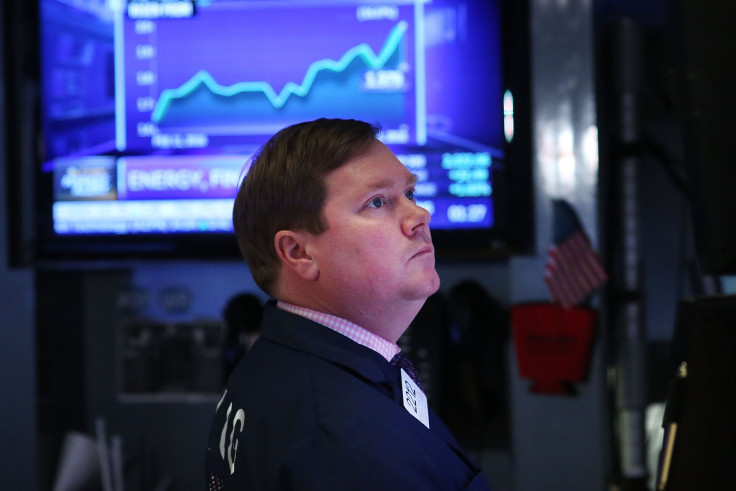Thursday's Stock Market Open: US Equities Plunge As CDC Confirmed Coronavirus Case In California

KEY POINTS
- Saudi Arabia has temporary banned Muslim pilgrims from entering kingdom
- U.S. 4Q GDP revision unchanged at 2.1%
- Durable goods orders slipped by 0.2% in January
Update: 12:05 p.m. EDT:
U.S. stocks recorded heavy losses at noon trading on Thursday, although the market was above mid-morning lows.
The Dow Jones Industrial Average plunged 481.63 points to 26,475.96 while the S&P 500 tumbled 53.10 points to 3,063.29 and the Nasdaq Composite Index dropped 184.21 points to 8,796.57.
At one point the Dow was down by as much as 900 points.
In Europe markets finished broadly lower as Britain’s FTSE-100 plunged 3.49%, France’s CAC-40 plummeted 3.32% and Germany’s DAX dropped 3.19%.
West Texas Intermediate crude futures were down 4.47% to $46.55 per barrel. The yield on the 10-Year Treasury was down to 1.3%
“We’re extremely cautious in the short term,” said Tom Hainlin, global investment strategist at Ascent Private Capital Management. “No one really seems to be an expert on the coronavirus. We haven’t seen anything like this really in our investing lifetimes.”
Update: 10:45 a.m. EDT:.
U.S. stocks suffered deeper losses in mid-morning trade on Thursday.
The Dow Jones Industrial Average plunged 748.22 points to 26,209.37 after sinking 954 points. The S&P 500 tumbled 87.54 points to 3,028.85 and the Nasdaq Composite Index dropped 291.55 points to 8,689.23.
West Texas Intermediate crude oil futures were down 5.6% to under $46 per barrel.
The National Association of Realtors said pending home sales in January rose 5.2%, well above expectations.
Original story:
U.S. stocks opened lower on Thursday after U.S. Centers for Disease Control and Prevention reported a coronavirus case in northern California of unknown origin.
The Dow Jones Industrial Average dropped 475.5 points to 26,482.19 while the S&P 500 slipped 58.76 points to 3,057.63 and the Nasdaq Composite Index plunged 206.49 points to 8,774.28.
Ten-year Treasury yields were at all-time lows.
The CDC reported a coronavirus case of “unknown origin” in Solano County in Northern California, suggesting the disease may be spreading. The CDC could not determine how the patient contracted the virus. “It’s possible this could be an instance of community spread of COVID-19, which would be the first time this has happened in the United States,” CDC said.
On Wednesday, health officials in Nassau County in New York State said they were monitoring and testing 83 people who might have had exposure to the coronavirus.
“We’ve hit a pocket of fear,” said Gregory Faranello, head of U.S. rates trading at AmeriVet Securities. “This is a big deal. If this [fear of virus] flows into the U.S., we could be in trouble because, let’s face it, the U.S. consumer is what’s holding this thing together.”
In a Wednesday evening press conference, President Donald Trump assured the risk of coronavirus is still “very low” in the U.S. and that the government will “spend whatever’s appropriate” to respond with the virus.
More than 80,000 people around the world have contracted the virus, but mostly in China. South Korea reported more than 1,200 cases, while Italy said 400 people have contracted the virus. Saudi Arabia has temporary banned Muslim pilgrims from entering the kingdom.
“The fact that, not only, is there no sign yet of the pathogen being contained, but rather we now also face the specter of it spreading through the U.S., will continue to weigh on the global macro outlook for the coming months,” said Simon Ballard, chief economist at First Abu Dhabi Bank. “Buckle up for continued high volatility and escalating risk aversion.”
Economist Zhang Anyuan warned that China might see zero or negative growth in its gross domestic product in the first quarter
In U.S. economic news, the Commerce Department said Thursday that durable goods orders slipped by 0.2% in January after rising 2.9% in December. Excluding the volatile transportation sector orders, durable goods orders rose by 0.9% January, the fastest pace since April 2018.
The Labor Department said initial jobless claims edged up by 8,000 to a one-month high of 219,000 for the week ended Feb. 22.
The Commerce Department also reported that a second revision of fourth quarter gross domestic product kept the rate unchanged at 2.1%, although the growth rate of consumer spending was downwardly revised to an 1.7% increase from 1.8%.
“As this week’s selling has progressed, we have seen some evidence of increased caution on the part of investors,” said Willie Delwiche, investment strategist at Baird. “Investors are shifting away from excessive optimism but there is still little evidence of fear overwhelming complacency.”
Overnight in Asia, markets finished mixed. China’s Shanghai Composite edged 0.11%, while Hong Kong’s Hang Seng gained 0.31%, and Japan’s Nikkei-225 fell 2.13%.
In Europe markets traded deeply lower as Britain’s FTSE-100 plunged 3.28%, France’s CAC-40 plummeted 3.75% and Germany’s DAX dropped 3.59%.
Crude oil futures plunged 4.9% at $46.34 per barrel and Brent crude fell 2.1% at $50.71. Gold futures gained 0.72%.
The euro rose 0.85% at $1.0974 while the pound sterling slipped 0.23% at $1.287.
© Copyright IBTimes 2025. All rights reserved.





















